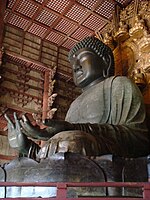| Śrīmahādevī (Buddhism) | |
|---|---|
 | |
| Sanskrit | श्रीमहादेवी Śrīmahādevī |
| Chinese | 吉祥天 (Pinyin: Jíxiáng tiān) |
| Japanese | 吉祥天 or 吉祥天
(romaji: Kichijōten) |
| Korean | 길상천
(RR: Gilsang Cheon) |
| Tagalog | Slimahadevi |
| Tibetan | ལྷ་མོ་ཆེན་མོ་དཔལ།་ Wylie: lha mo chen mo dpal |
| Vietnamese | Cát Tường Thiên |
| Information | |
| Venerated by | Mahāyāna, Vajrayāna |
Kisshōten (吉祥天, lit. "Auspicious Heavens"), also known as Kichijōten, Kisshoutennyo (吉祥天女), or Kudokuten (功徳天), is a Japanese female deity, Kisshoutennyo is sometimes named as one of the Seven Gods of Fortune (fukujin), replacing either Jurōjin or Fukurokuju. For example, in the 1783 edition of the Butsuzōzui compendium (reprinted in 1796), Kichijōten replaces Fukurokuju as one of the seven fukujin. She is considered to be the goddess of happiness, fertility, and beauty. Kisshoutennyo's iconography is distinguished by the Nyoihōju gem (如意宝珠) in her hand, Kisshōten and the Nyoihōju gem are both represented by the symbol of the kagome.
When Kisshoutennyo is counted among the seven fukujin and fellow Fukujin Daikoku is regarded in feminine form, all three of the Hindu Tridevi goddesses are then represented among the seven Fukujin.
See also
- Buddhist Tenbu (天部) deities
- Fukujin (福神) deities
- Hinduism in Japan
- Kagome crest
- Kagome lattice
- Kisshō Tennyo (manga)
- Lakshmi
- Nyoihōju (如意宝珠) wishing gem
- Satkona
- Vasudhara (Bodhisattva of good fortune, wealth, fertility, prosperity)
References
- ^ "Wooden figure of Kichijōten". The British Museum. Retrieved 27 August 2012.
- ^ "Butsuzōzui (Illustrated Compendium of Buddhist Images)" (in Japanese). Ehime University Library. 1796. p. (077.jpg). Archived from the original (digital photos) on 10 October 2018. Retrieved 14 May 2016.
- "Kichijoten Japanese Lucky Goddess of Beauty". 10 February 2023. Archived from the original on 10 February 2023. Retrieved 1 March 2023.
{{cite web}}: CS1 maint: bot: original URL status unknown (link) - "Kisshōten (Kichijōten)". Philadelphia Museum of Art. Retrieved 27 August 2012.
- Neighbour-Parent, Mary. "Kichijouten 吉祥天". JAANUS. Atsumi International Scholarship Foundation.
- "Butsuzōzui (Illustrated Compendium of Buddhist Images)" (in Japanese). Ehime University Library. 1796. p. (059.jpg). Archived from the original (digital photos) on 10 October 2018. Retrieved 14 May 2016.
External links
[REDACTED] Media related to Kichijouten at Wikimedia Commons
| Japanese mythology | ||
|---|---|---|
| Mythic texts |   | |
| Japanese creation myth | ||
| Takamagahara mythology | ||
| Izumo mythology | ||
| Hyūga mythology | ||
| Human age | ||
| Mythological locations | ||
| Mythological weapons | ||
| Major Buddhist figures | ||
| Seven Lucky Gods | ||
| Legendary creatures | ||
| Other | ||
This article relating to Japanese mythology is a stub. You can help Misplaced Pages by expanding it. |
This article related to religion in Japan is a stub. You can help Misplaced Pages by expanding it. |
